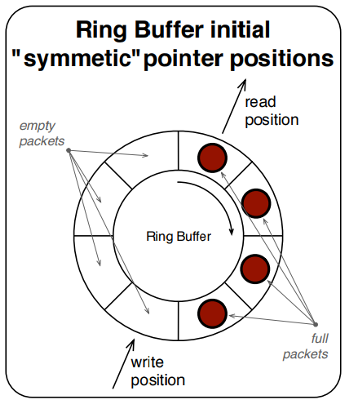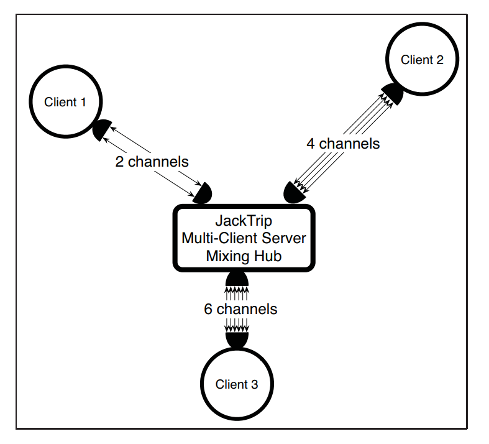Online Jamming and Concert Technology
Music 153
Autumn 2018
worldwide course
Navigate this deck with keyboard or touch
type "m" for the menu of pages and
arrow or page keys to advance or rewind
two-finger tap for the menu of pages and
the usual left/right swipe to advance or rewind
Online Jamming and Concert Technology
Music 153
Autumn 2018
type "m" for the menu of pages and
arrow or page keys to advance or rewind
two-finger tap for the menu of pages and
the usual left/right swipe to advance or rewind
Today's vast amount of streaming and video conferencing on the Internet lacks one aspect of musical fun and that's what this course is about: high-quality, near-synchronous musical collaboration. Under the right conditions, the Internet can be used for ultra-low-latency, uncompressed sound transmission. The course teaches open-source (free) techniques for setting up city-to-city studio-to-studio audio links. Distributed rehearsing, production and split ensemble concerts are the goal. Setting up such links and debugging them requires knowledge of network protocols, network audio issues, mics, monitors and some ear training.
The one-quarter course has two parts: a 6-week, hands-on online class for learning and practicing the basics, followed by 3 weeks of projects and advanced topics. The initial online course materials cover fundamentals and getting started. Weekly in-class meetings throughout the quarter will provide tips on software installation, testing, readings and offer related tutorials. We'll survey the history of the field and move on to discussions of emerging low-latency collaboration technologies involving video, GPS-sync, web audio and audio prediction. Recent doctoral dissertations will be presented. End-of-term culminating projects chosen by students can be live performances with remote partners, recorded work or technical contributions for online collaboration.
(the course can be repeated for credit)
Stanford students taking the first part of the course will be joining other students worldwide. Sharing course work universally is strongly recommended and Stanford students will be asked to sign a simple release form. Options will be provided for any student preferring their work remain within Stanford. Some of the assignments involve jointly-created music and all collaborations posted on the course web site under a Creative Commons License (either CC BY-SA 3.0 US or CC BY NC SA).
The first part of the course is offered by Stanford ONLINE and hosted at www.kadenze.com. Stanford participants will enroll as Kadenze subscribers for a fee of $20.
prerequisites
some coding skill at an introductory level, musical instrument or vocals
advanced topics in (Autumn 2018)
design of distributed, ephemeral back-end systems for bands and collectives -- continuation of concept begun in Spring class
porting jacktrip to raspberry pi -- to support collaboration with artist group in Berlin
Network Music Performance (NMP) doctoral dissertations -- Bosse, Weaver, Ota, Caceres, Sarkar, Carot, Barbosa
jacktrip v1.2 testing -- with NYU, others
prerequisites
some coding skill at an introductory level, musical instrument or vocals
advanced topics in (Autumn 2018)
design of distributed, ephemeral back-end systems for bands and collectives -- continuation of concept begun in Spring class
porting jacktrip to raspberry pi -- to support collaboration with artist group in Berlin
Network Music Performance (NMP) doctoral dissertations -- Bosse, Weaver, Ota, Caceres, Sarkar, Carot, Barbosa
jacktrip v1.2 testing -- with NYU, others
schedule overview Autumn Quarter, 2018
online course (6 weeks)
24 Sep -- 31 Oct
readings, in-class discussion and activities (8 weeks)
24 Sep -- 14 Nov
Thanksgiving break
19 Nov -- 23 Nov
final projects and presentations (2 weeks)
26 Nov -- 7 Dec
online course (6 weeks)
24 Sep -- 31 Oct
readings, in-class discussion and activities (8 weeks)
24 Sep -- 14 Nov
Thanksgiving break
19 Nov -- 23 Nov
final projects and presentations (2 weeks)
26 Nov -- 7 Dec
week of 24 Sep 2018
In-class:
Stanford course overview, first group improvs, discussions of history of the technology
Naithan Bosse composition, Through a Window
Reading:
Telematic Music: Six Perspectives Leonardo Music J., 19 (2009) 95–96
Online Session 1:
Overview: Online Jamming and Concert Technology
(no meeting Wed, 26th)
In-class:
Stanford course overview, first group improvs, discussions of history of the technology
Naithan Bosse composition, Through a Window
Reading:
Telematic Music: Six Perspectives Leonardo Music J., 19 (2009) 95–96
Online Session 1:
Overview: Online Jamming and Concert Technology
(no meeting Wed, 26th)
week of 1 Oct 2018
In-class:
CCRMA accounts, technical discussion of available video techniques, improv duos
Sarah Weaver composition, Universal Synchrony Music
Online Session 2:
Basics And Setup: Network protocols, audio signals + soundcards and network audio
In-class:
CCRMA accounts, technical discussion of available video techniques, improv duos
Sarah Weaver composition, Universal Synchrony Music
Online Session 2:
Basics And Setup: Network protocols, audio signals + soundcards and network audio
week of 8 Oct 2018
In-class:
local connections betwen Knoll studios, campus-wide connections
Reading:
Caceres, J.-P. and Chafe, C. . "Jacktrip: Under the hood of an engine for network audio." J. New Music Res. 39 (2010) 183–187. doi:10.1080/09298215.2010.481361
Online Session 3:
Jacktrip Application + Connection: Things that go wrong with Jacktrip: Network & Audio. P2P Sessions and Multi-site setups
In-class:
local connections betwen Knoll studios, campus-wide connections
Reading:
Caceres, J.-P. and Chafe, C. . "Jacktrip: Under the hood of an engine for network audio." J. New Music Res. 39 (2010) 183–187. doi:10.1080/09298215.2010.481361
Online Session 3:
Jacktrip Application + Connection: Things that go wrong with Jacktrip: Network & Audio. P2P Sessions and Multi-site setups
week of 15 Oct 2018
In-class:
multi-studio connections including multi-studio group improv, critique of historical recordings
Online Session 4:
Debugging: Debug examples of typical problems
In-class:
multi-studio connections including multi-studio group improv, critique of historical recordings
Online Session 4:
Debugging: Debug examples of typical problems
week of 22 Oct 2018
In-class:
class jam with UCSB, "Nemasys" network emulator for testing audio "on the bench" under different network conditions (artificial impairments)
Reading:
C. Chafe, J-P. Caceres, M. Gurevich, "Effect of temporal separation on synchronization in rhythmic performance" Perception 39(7) (2010) 982–992
Online Session 5:
Future: Polish And Practice: Polish techniques and spawn more online practice sessions
In-class:
class jam with UCSB, "Nemasys" network emulator for testing audio "on the bench" under different network conditions (artificial impairments)
Reading:
C. Chafe, J-P. Caceres, M. Gurevich, "Effect of temporal separation on synchronization in rhythmic performance" Perception 39(7) (2010) 982–992
Online Session 5:
Future: Polish And Practice: Polish techniques and spawn more online practice sessions
week of 29 Oct 2018
In-class:
discuss project proposals, presentation of recent research topics
Reading:
C. Rottondi, C. Chafe, C. Allochio, A. Sarti "An Overview on Networked Music Performance Technologies" IEEE Access 4 (2017) 8823–8843
Online Session 6:
Future: Future of the art and practice of network audio, alternative platforms for network audio
(no meeting Wed, 31st)
In-class:
discuss project proposals, presentation of recent research topics
Reading:
C. Rottondi, C. Chafe, C. Allochio, A. Sarti "An Overview on Networked Music Performance Technologies" IEEE Access 4 (2017) 8823–8843
Online Session 6:
Future: Future of the art and practice of network audio, alternative platforms for network audio
(no meeting Wed, 31st)
week of 5 Nov 2018
In-class:
building jacktrip from scratch for three platforms, discuss future platforms (javascript, included)
Reading:
J-P. Caceres, C. Chafe, "JackTrip/SoundWIRE Meets Server Farm" Computer Music J. 34(3) (2010) 29–34
In-class:
building jacktrip from scratch for three platforms, discuss future platforms (javascript, included)
Reading:
J-P. Caceres, C. Chafe, "JackTrip/SoundWIRE Meets Server Farm" Computer Music J. 34(3) (2010) 29–34
week of 12 Nov 2018
In-class:
progress updates and more
Reading:
Chafe, C. "I am Streaming in a Room" Frontiers in Digital Musicology. (2018) (forthcoming)
In-class:
progress updates and more
Reading:
Chafe, C. "I am Streaming in a Room" Frontiers in Digital Musicology. (2018) (forthcoming)
week of 19 Nov 2018
Thanksgiving break
week of 26 Nov 2018
In-class:
project presentations
In-class:
project presentations







